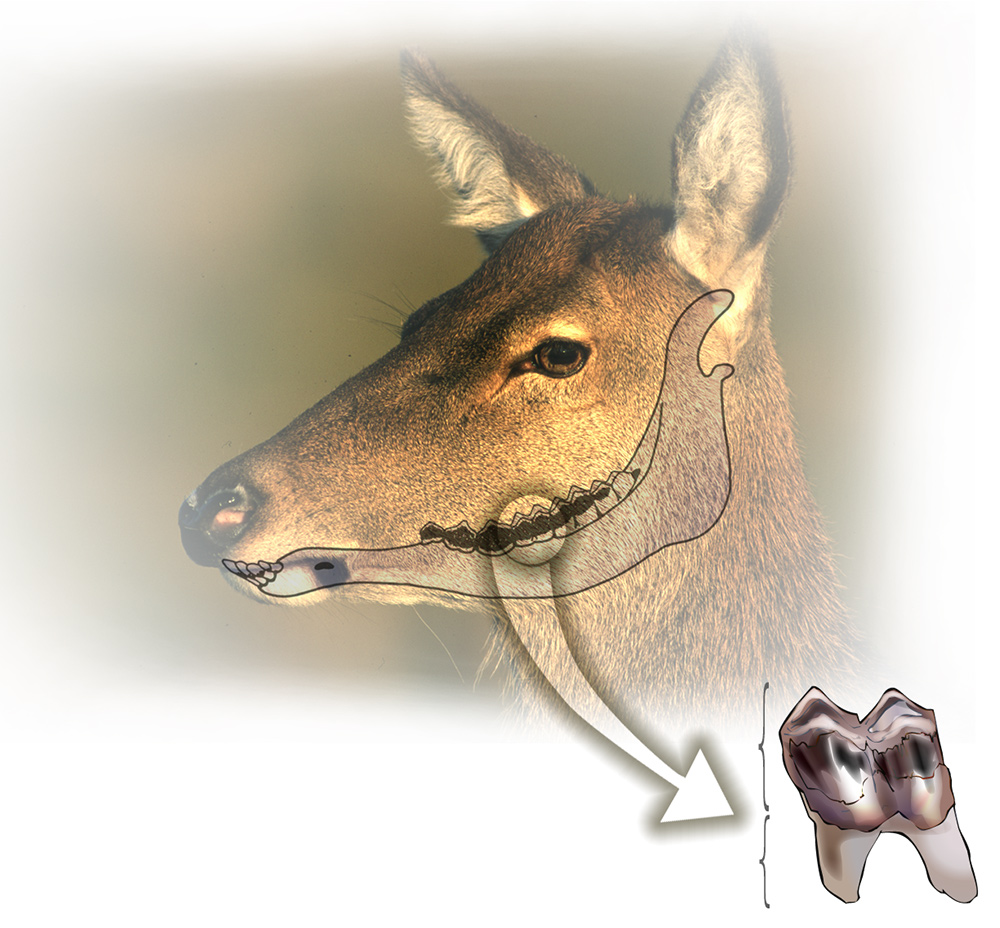
with close up of the two cusps (brackets indicate the crown at top and root below)
Introduction
This guide describes how the teeth of culled deer can be used to help confirm the age class of culled animals. It links to the Assessing age guide which should be regarded as important companion reading.
Accuracy
Estimates of age can be based on both tooth eruption patterns and tooth wear. The progress of tooth eruption in young deer is accurate to within a month or so. For adults tooth wear must be used. It is less accurate but can at least indicate the age class, if not the specific age in years. Where locally obtained known-aged jaws are available to allow comparison, it may be possible to make more detailed estimates of age using wear. Accuracy is also improved if the jaw is removed and examined as a dry specimen but estimates carried out on the fresh carcass may be adequate for most purposes.
Alternative methods such as sectioning teeth to examine cement layers (equivalent to age rings in trees) are available but can be laborious and difficult to interpret.
Which teeth
The “cheek teeth” i.e. the pre-molars and molars in the lower jaw are most used in estimating age because they are the most accessible and yield the most information. It is worth checking that both sides of the jaw are similar as there can be differences, especially in adult tooth wear.
Tooth eruption
Deer are born with three deciduous (milk) pre-molars (pm i, ii, iii), these are eventually replaced by permanent teeth as the animal becomes an adult. pmiii has three cusps, making it very different from the adult PM3 that will replace it.
The first adult tooth to appear is molar 1 (M1 ) which is followed by M2 and M3 then PM 1,2,3 which appear in rapid succession as they push out the milk pre-molars from below.
The tooth eruption pattern is consistent for individuals of the same species and age regardless of where they are from. Between species there are differences (see Table 1), but any deer with a three-cusped third pre-molar(pmiii) has not yet got its full complement of adult teeth and is therefore not an adult.
M3 is a large tooth and in many deer it takes a long time for the rearward cusp to become stained and come into wear even after all of the adult teeth are present, thus it can be useful in identifying young adults.
Table 1 – tooth eruption
Species Eruption
| Species | Eruption | ||
| Permanent cheek teeth present in lower jaw at 12-14 months | Approx age that all permanent teeth are present (if not yet fully in wear). PM3 does not have 3 cusps | Rear cusp of third molar is beginning to wear | |
| Red | M1 – M2 | 30 months | 36-48 months |
| Fallow | M1 – M2 | 26 months | 36-48 months |
| Sika | M1 – M2 | 26 months | 36-48 months |
| Muntjac | M1 – M3 | 19 months | 25-34 months |
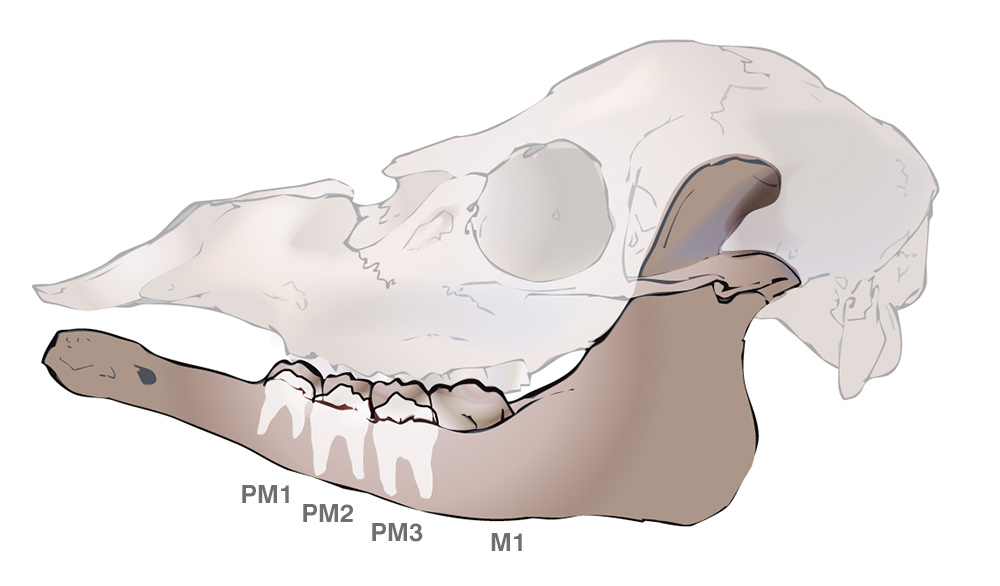
calf/ fawn lower jaw showing the premolars (white) pushing out the milk teeth (the brown cusps) above them, with M1 behind them
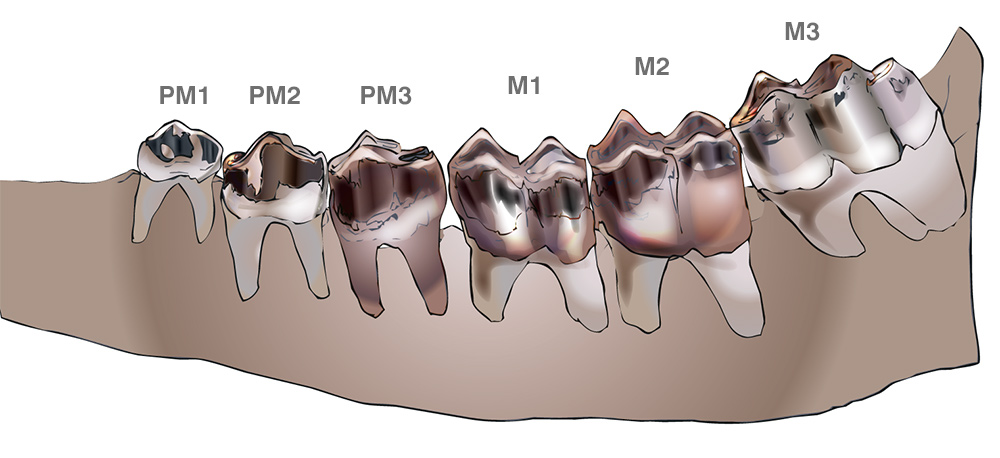
adult jaw, showing M3 with a third single cusp which is smaller and at the rear
Tooth wear
The wear pattern of adult teeth is not completely reliable for ageing but in general, young adult teeth are high and sharp and get progressively lower and smoother as they age. As the teeth wear the pattern of dentine, enamel and size of the infundibulum changes (see Table 2).
Adult teeth may break up and be lost in old age and tooth wear can be one of the limiting factors in any deer’s life-span.
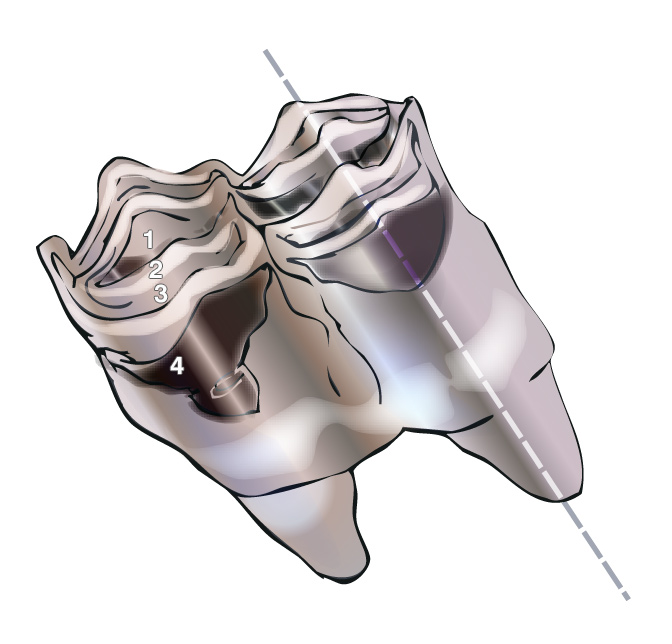
young tooth showing 1: infundibulum; 2: enamel (white); 3: dentine (brown); 4: tartar stain
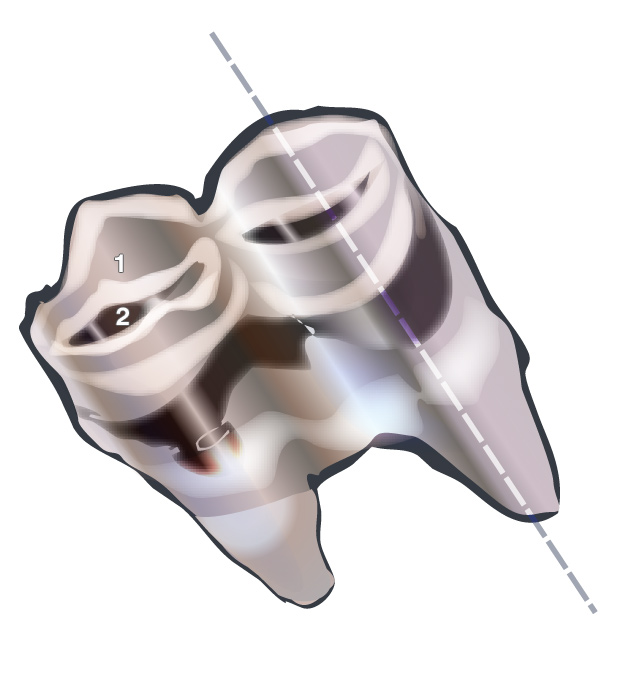
Older tooth shows (1) the brown dentine becoming wider than white enamel on all cusps, while (2) a line of enamel has formed a ring around the infundibulum

vertical cross section of tooth showing wear down from the top, with (1) young enamel is wider than dentine; (2) older dentine is wider than enamel; (3) old infundibulum disappears
Further Info
Chapman, N. (2006) How old is that muntjac? DEER 14 (2) pp 25-28
Brown,W.A.B. & Chapman,N. (1990) The dentition of fallow deer (Dama dama): A scoring scheme to assess age from wear of the permanent molariform teeth. J.Zool.,Lond 221,659-682
Brown,W.A.B. & Chapman, Norma (1991) The dentition of red deer (Cervus elaphus): A scoring scheme to assess age from wear of the permanent molariform teeth. J.Zool.,Lond 224,519-536
Chapman, N., Brown W.A.B., Rothery, P. 2005 Assessing the age of Reeves’ muntjac (Muntiacus reevesi) by scoring wear of the mandibular molars. J.Zool.,Lond 267,233-247
Mitchell, B. and Youngson, R.W. (1969) Teeth and Age in Scottish red deer – a practical guide to the determination of age. The Red Deer Commission Annual Report for 1968
Chapman, D. Chapman, N. (1997) Fallow Deer: Their History, Distribution and Biology